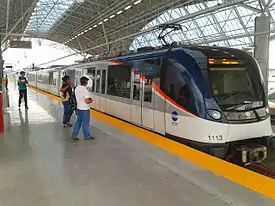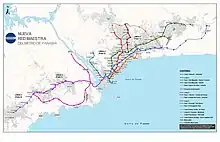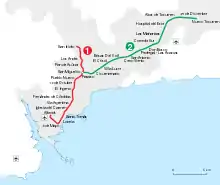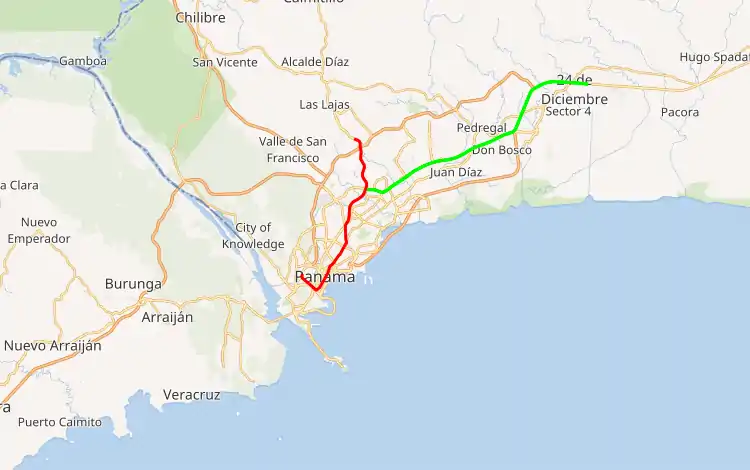Panama Metro
The Panama Metro (Spanish: Metro de Panamá) is a rapid transit system in Panama City, Panama,[6] which links the north and east sides of the metropolitan area to the city center. It was inaugurated on April 5, 2014, and entered revenue service two weeks later.[7]
 | |||||||||||||||||||||||||||||||||||||||||||||||||||||||||||||||||||||||||||||||||||||||||||||||||||||||||||||||||||||||||||||||||||||||||||||||||||||||||||||||||||||||||||||||||||||||||||||||||||||||||||||||||||
 Alstom Metropolis on Line 1 (2014) | |||||||||||||||||||||||||||||||||||||||||||||||||||||||||||||||||||||||||||||||||||||||||||||||||||||||||||||||||||||||||||||||||||||||||||||||||||||||||||||||||||||||||||||||||||||||||||||||||||||||||||||||||||
| Overview | |||||||||||||||||||||||||||||||||||||||||||||||||||||||||||||||||||||||||||||||||||||||||||||||||||||||||||||||||||||||||||||||||||||||||||||||||||||||||||||||||||||||||||||||||||||||||||||||||||||||||||||||||||
|---|---|---|---|---|---|---|---|---|---|---|---|---|---|---|---|---|---|---|---|---|---|---|---|---|---|---|---|---|---|---|---|---|---|---|---|---|---|---|---|---|---|---|---|---|---|---|---|---|---|---|---|---|---|---|---|---|---|---|---|---|---|---|---|---|---|---|---|---|---|---|---|---|---|---|---|---|---|---|---|---|---|---|---|---|---|---|---|---|---|---|---|---|---|---|---|---|---|---|---|---|---|---|---|---|---|---|---|---|---|---|---|---|---|---|---|---|---|---|---|---|---|---|---|---|---|---|---|---|---|---|---|---|---|---|---|---|---|---|---|---|---|---|---|---|---|---|---|---|---|---|---|---|---|---|---|---|---|---|---|---|---|---|---|---|---|---|---|---|---|---|---|---|---|---|---|---|---|---|---|---|---|---|---|---|---|---|---|---|---|---|---|---|---|---|---|---|---|---|---|---|---|---|---|---|---|---|---|---|---|---|---|
| Native name | Metro de Panamá | ||||||||||||||||||||||||||||||||||||||||||||||||||||||||||||||||||||||||||||||||||||||||||||||||||||||||||||||||||||||||||||||||||||||||||||||||||||||||||||||||||||||||||||||||||||||||||||||||||||||||||||||||||
| Owner | Metro de Panamá, S.A. | ||||||||||||||||||||||||||||||||||||||||||||||||||||||||||||||||||||||||||||||||||||||||||||||||||||||||||||||||||||||||||||||||||||||||||||||||||||||||||||||||||||||||||||||||||||||||||||||||||||||||||||||||||
| Locale | Panama City, Panama | ||||||||||||||||||||||||||||||||||||||||||||||||||||||||||||||||||||||||||||||||||||||||||||||||||||||||||||||||||||||||||||||||||||||||||||||||||||||||||||||||||||||||||||||||||||||||||||||||||||||||||||||||||
| Transit type | Rapid transit | ||||||||||||||||||||||||||||||||||||||||||||||||||||||||||||||||||||||||||||||||||||||||||||||||||||||||||||||||||||||||||||||||||||||||||||||||||||||||||||||||||||||||||||||||||||||||||||||||||||||||||||||||||
| Number of lines | 2 (operational)[1], 3 (planned) | ||||||||||||||||||||||||||||||||||||||||||||||||||||||||||||||||||||||||||||||||||||||||||||||||||||||||||||||||||||||||||||||||||||||||||||||||||||||||||||||||||||||||||||||||||||||||||||||||||||||||||||||||||
| Number of stations | 29[1] (1 more planned)[2] | ||||||||||||||||||||||||||||||||||||||||||||||||||||||||||||||||||||||||||||||||||||||||||||||||||||||||||||||||||||||||||||||||||||||||||||||||||||||||||||||||||||||||||||||||||||||||||||||||||||||||||||||||||
| Daily ridership | 180,000 (March 2015)[3] | ||||||||||||||||||||||||||||||||||||||||||||||||||||||||||||||||||||||||||||||||||||||||||||||||||||||||||||||||||||||||||||||||||||||||||||||||||||||||||||||||||||||||||||||||||||||||||||||||||||||||||||||||||
| Annual ridership | 81,500,000+ | ||||||||||||||||||||||||||||||||||||||||||||||||||||||||||||||||||||||||||||||||||||||||||||||||||||||||||||||||||||||||||||||||||||||||||||||||||||||||||||||||||||||||||||||||||||||||||||||||||||||||||||||||||
| Website | El Metro de Panamá | ||||||||||||||||||||||||||||||||||||||||||||||||||||||||||||||||||||||||||||||||||||||||||||||||||||||||||||||||||||||||||||||||||||||||||||||||||||||||||||||||||||||||||||||||||||||||||||||||||||||||||||||||||
| Operation | |||||||||||||||||||||||||||||||||||||||||||||||||||||||||||||||||||||||||||||||||||||||||||||||||||||||||||||||||||||||||||||||||||||||||||||||||||||||||||||||||||||||||||||||||||||||||||||||||||||||||||||||||||
| Began operation | April 6, 2014 | ||||||||||||||||||||||||||||||||||||||||||||||||||||||||||||||||||||||||||||||||||||||||||||||||||||||||||||||||||||||||||||||||||||||||||||||||||||||||||||||||||||||||||||||||||||||||||||||||||||||||||||||||||
| Operator(s) | Metro de Panamá, S.A. (state owned enterprise) | ||||||||||||||||||||||||||||||||||||||||||||||||||||||||||||||||||||||||||||||||||||||||||||||||||||||||||||||||||||||||||||||||||||||||||||||||||||||||||||||||||||||||||||||||||||||||||||||||||||||||||||||||||
| Character | partially underground, partially elevated | ||||||||||||||||||||||||||||||||||||||||||||||||||||||||||||||||||||||||||||||||||||||||||||||||||||||||||||||||||||||||||||||||||||||||||||||||||||||||||||||||||||||||||||||||||||||||||||||||||||||||||||||||||
| Number of vehicles | 47 | ||||||||||||||||||||||||||||||||||||||||||||||||||||||||||||||||||||||||||||||||||||||||||||||||||||||||||||||||||||||||||||||||||||||||||||||||||||||||||||||||||||||||||||||||||||||||||||||||||||||||||||||||||
| Train length | 5-car trainsets[4] | ||||||||||||||||||||||||||||||||||||||||||||||||||||||||||||||||||||||||||||||||||||||||||||||||||||||||||||||||||||||||||||||||||||||||||||||||||||||||||||||||||||||||||||||||||||||||||||||||||||||||||||||||||
| Technical | |||||||||||||||||||||||||||||||||||||||||||||||||||||||||||||||||||||||||||||||||||||||||||||||||||||||||||||||||||||||||||||||||||||||||||||||||||||||||||||||||||||||||||||||||||||||||||||||||||||||||||||||||||
| System length | 36.8 km (22.9 mi)[5] | ||||||||||||||||||||||||||||||||||||||||||||||||||||||||||||||||||||||||||||||||||||||||||||||||||||||||||||||||||||||||||||||||||||||||||||||||||||||||||||||||||||||||||||||||||||||||||||||||||||||||||||||||||
| Track gauge | 1,435 mm (4 ft 8 1⁄2 in) standard gauge | ||||||||||||||||||||||||||||||||||||||||||||||||||||||||||||||||||||||||||||||||||||||||||||||||||||||||||||||||||||||||||||||||||||||||||||||||||||||||||||||||||||||||||||||||||||||||||||||||||||||||||||||||||
| Electrification | 1500 V DC overhead lines | ||||||||||||||||||||||||||||||||||||||||||||||||||||||||||||||||||||||||||||||||||||||||||||||||||||||||||||||||||||||||||||||||||||||||||||||||||||||||||||||||||||||||||||||||||||||||||||||||||||||||||||||||||
| |||||||||||||||||||||||||||||||||||||||||||||||||||||||||||||||||||||||||||||||||||||||||||||||||||||||||||||||||||||||||||||||||||||||||||||||||||||||||||||||||||||||||||||||||||||||||||||||||||||||||||||||||||
It was built to relieve the traffic congestion between the city and San Miguelito District, and to offer commuters a viable alternative to road transport, as the Metrobus transport system is suffering multiple issues.
The Metro operates seven days a week and 365 days a year: Monday-Friday 05:00-23:00, Saturday 05:00-22:00 and on Sunday and holidays 07:00-22:00.[8]
The Panama Metro is part of a major "National Master Plan" to improve transportation in Panama City and the west side of the country, which includes the construction of three more metro lines and a light rail line. It consists of two lines. The 15.8-kilometer (9.8 mi) line one,[5] serves fourteen stations,[1] with a fifteenth station planned.[2] Line two, opened partially and temporarily on January 14 to 17, 2019 for the week of the World Youth Day and completely on April 24 of the same year and covers a 21-kilometer (13 mi) route and serves sixteen stations, with San Miguelito being the interchange station for both lines.[9][10][11]
History
Development


The Government of Panama invited tenders for a contract to build the metro system.[12] The governments of Brazil[13] and Taiwan[14] offered to invest on the project. After an exhaustive inspection of all proposals for the construction of the railway system, the Línea Uno consortium, which includes the Spanish Fomento de Construcciones y Contratas (FCC), won the contract.[15]
In October 2009, the POYRY/Cal y Mayor y Asociados consortium won the contract for the counseling of the project development,[16] and on January 2010, Systra was awarded a contract to create detailed infrastructure designs.
The first phase of the project consisted of planning, cost estimation, and technical feasibility, while the second phase consisted of several soil studies, topography, and demand refinings. Both phases were started and executed simultaneously in late 2009.
Construction
In December 2010, the government finally awarded the tender for the construction of the subway. The third and fourth phases of the project took place between 2011 and 2012, and consisted of the construction of all the viaducts and stations and relocation of the public utilities. The control center that supervises the whole metro operations and the Automatic Train Supervision were provided by Thales, along with the network infrastructure and communication and security solutions including CCTV, telephony, intercom, TETRA radio, visual and audio information to passengers, and fire detection.
By September 2013, construction of Line 1 was 92% complete, allowing a test run with some of the rolling stock.[17]
Cost
The construction of Line 1 cost $1.452 billion. The Metro of Panama authority, in charge of the planning, construction, and execution of the project, has a budget of $200 million for the year 2012. In December 2011, the Secretaría del Metro de Panamá clarified that the updated cost of the project is US$1.880 billion, including public utilities relocations and engineering and project management costs.[18]
Early operations
On April 5, 2014, the metro's Line 1 was inaugurated, and the first public passenger trips on the new system were carried out. The next day, April 6, it entered into active passenger revenue service.[7] In its first year of operations the system carried 200,000 people per day on average, 25% more than had been expected.[19]
The initial segment of Panama Metro's Line 1 ran over a mostly north-south route, from Los Andes to the Albrook bus station (where the system's maintenance shop is located), and extended over 13.7 kilometers (8.5 mi) of route, including 7.2 kilometers (4.5 mi) underground and 6.5 kilometers (4.0 mi) elevated.[7] Initially, Line 1 had 11 passenger stations (with 3 more to be completed and opened after operations on Line 1 began): 5 elevated, 5 underground, and 1 at-grade. The twelfth station, Lotería, which was the sixth underground station, opened on August 27, 2014.[5] The El Ingenio subway station, located between the underground Fernández de Córdoba station and the first elevated station, 12 de Octubre, was originally scheduled to open in August 2014,[20] but opened on May 8, 2015.[21]
The original northern terminus station of the metro was Los Andes.[20] However, it was a temporary terminus station, since the government had approved an extension of Line 1 to a final elevated station in San Isidro.[22] San Isidro was also originally scheduled to open in August 2014, but finally opened on August 15, 2015.[23] The extension to San Isidro added 2.1 kilometers (1.3 mi) of route to the system, extending the metro's total route length to 15.8 kilometers (9.8 mi).[5]
Line 2 development
On May 16, 2014, three different consortiums offered several proposals for planning, cost estimation and technical feasibility for the construction of a Line 2 of the Metro system.[24] After making a detailed inquiry of all the proposals, the Metro de Panama secretary announced on July 12, 2014, that the PML2 consortium – which includes the Spanish "Ayesa Ingeniería y Arquitectura", "Barcelona Metro", and the "Louis Berger Group" company from the United States – had been awarded the contract.[25][26] The Line 2 project will have a cost of $2.200 billion.[27] It ended up costing 1.857 billion. [28]
The construction contract was awarded to Linea 2 Consortium, formed by Odebrecht from Brazil and FCC from Spain, the same consortium that built Line 1 of the Panama Metro. Construction officially started in September 2015.[29] Originally, Line 2 had to be delivered in April 2019, but, since Panama City is hosting the Catholic World Youth Summit in January 2019, construction was being accelerated and a new delivery date was announced as December 31, 2018 in order to serve the one million tourists that were expected to attend the summit.[30] However, in 2018, due to a one month long labor strike which eroded over $900 million USD from the annual GDP figure, and caused the same amount of losses, the delivery date was pushed back to the original delivery date. However, the first test ran with 12 trains for 8 hours was conducted on 28 December, with a partial opening on 15 January with five stations for the WYD, then it was closed again and re-open on the original date.[31] In August 2018 it was announced that line 2 would operate partially from Corredor Sur to San Miguelito 24 hours a day during the WYD.[32] In January 2019, it was announced that Line 2 would open from 18 to 28 January, with five stations operating, including 42 hours continuous operations on the 26th and 27th.[33]
Line 2 was formally opened on 25 April 2019. [29]
Operations
Line 1
_-_2014.jpg.webp)
Panama Metro's Line 1 runs over a mostly north-south route, from San Isidro to the Albrook bus station (where the system's maintenance shop is located), and extends over 15.8 kilometers (9.8 mi) of route, including 7.2 kilometers (4.5 mi) underground.[12] It has 14 passenger stations: 6 elevated, 7 underground, and 1 at-grade. The stations have a platform length of approximately 110 meters (360 ft).[1]
A complete journey of Line 1 lasts about 25 minutes. It begins its current route at the elevated San Isidro station, north of the city, continuing on viaduct via the original terminus of Los Andes, Pan de Azucar station, San Miguelito station, Pueblo Nuevo (close to the Estrella Azul factory) to reach 12 de Octubre (the final elevated station), where it enters a trench, towards the underground section of Line 1. It continues its journey through the underground stations of El Ingenio, Fernandez de Cordoba, Vía Argentina, Iglesia del Carmen, Santo Tomás, Lotería, and 5 de Mayo. Finally it reaches the terminus station, the system's only at-grade station, Albrook, with a bridge connection to the bus terminal and Albrook Mall, and close to Marcos A. Gelabert Airport (the secondary airport of Panama City).
There are also plans to develop an underground station in Curundú, between the underground 5 de Mayo station and the at-grade Albrook station, serving future city government facilities to be built at that location. It is expected to be constructed some time after the Metro has been opened.[20]
Operating hours
The Metro operates seven days a week and 365 days a year: Monday-Saturday 05:00-22:00 and on Sunday and holidays 07:00-22:00.
Rolling stock
Alstom has delivered 19 three-car Metropolis trainsets for the Panamá Metro.[34] The trains were built at Alstom's Santa Perpètua de Mogoda factory in Spain and underwent preliminary testing on the FGC network in Barcelona. Some trains now have five cars, instead of three.
The first three trains were shipped from Spain and arrived May 25, 2013. The standard gauge units have air-conditioning, CCTV, and passenger information, and can accommodate 600 passengers per trainset.[35] The trains initially consist of three-car sets, but all stations are being built to accommodate five-car trainsets in anticipation of expected future ridership demands.
Like most rapid transit systems in Latin America, but unlike other systems in the rest of the Americas, the Panama Metro does not have a third rail. Instead, the trains collect their power from an overhead line system using a pantograph and a rigid I beam shaped overhead line that runs at 1500 volts DC,[36] with 25 and 15 KV 60 Hz AC used for power distribution to the power substations which supply the DC power. The rolling stock is very similar to the Barcelona Metro 9000 Series.
Planned expansion
The metro is eventually planned to extend to 10 lines, plus a branch line to the Tocumen airport and ITSE, by 2040 or 2035.[37] The first five lines will be metro lines, with the last three as tram lines, a metrocable-like system for San Miguelito and a monorail line for the planned city of Panama Pacifico, in Panama Oeste.[37][38][39]
Line 1 will extend by one station to Villa Zaita to the north of San Isidro. And the Curundu station will be opened sometime in 2024.[37]
Line 2 will run for 29 km from Parque Urraca, in the Punta Pacifica district to Felipillo and will be built in three phases.[37] The first phase will run from San Miguelito to Nuevo Tocumen. The first phase of construction took four years.[40] Construction on Line 2 broke ground on October 5, 2015, with construction expected to take 44 months.[41]
The second phase (Line 2A) will then extend this line from San Miguelito to either Parque Urraca or Punta Pacifica located in the south part of Panama City. It will be almost completely underground. Line 2A will only measure 9 kilometers in length, but building a metro line underground costs three times as much as building it as an elevated metro line, so Line 2A could cost as much as Line 2. [42][43] The final phase will extend the line by one station, from Nuevo Tocumen to Felipillo.[37] Phase 1 has a length of 21 km and as September 2018 the new line was 85% complete, allowing for test runs until Cerro Viento station with 4 (5 wagon) trains. By November 2018, test runs covered the entire length of phase 1. 14 trains were operational in the World Youth Day in January 2019 in manual mode at a top speed of 40 km/h, in normal operation trains will run autonomously at 70 km/h with the driver only supervising the train's systems. A branch line is proposed that would start on Condado del Rey station and run along the Via Centenario until it reaches MERCA Panama.[44]
Line 3 is planned to have 14 stations and will run from Albrook station to Arraiján, Nuevo Chorrillo to the terminus in Ciudad del Futuro. The total length will be 26.7km.[45] Negotiations with the Japanese Government started in 2012 with President Ricardo Martinelli's visit to Japan[46] In 2014, in a meeting held by Fumio Kishida, Japan's Foreign Minister and Francisco Alvarez de Soto, Panama's Foreign Minister, a joint statement was issued including "Panama City Urban Transportation Line-3 Project".[47] In April 2016, it was announced that Line 3 would be financed by a loan from the Japanese government, and use Japanese technology with trains from Hitachi monorail. Line 3 will be built in 2 phases, with the second phase having its terminus in La Chorrera.[48]
Nippon Koei Co,[49] a Japanese consulting firm, is in charge of project management of Line 3 of Metro of Panama.
It was announced in October 2018 that an agreement had been reached with Hitachi to provide the ALWEG monorail trains and platform screen doors for line 3 at a cost of over US$ 800 million.
The final two metro lines, Line 4 and Line 5, will run from Pedregal - Via Israel and Costa Del Este to Obarrio, respectively.[37]
The remaining lines will be tram lines. Line 6 will run from Albrook to Ciudad de la Salud. Line 7 will be oriented toward tourists and will run through the Casco Antiguo district and line 8 from Don Bosco to Villa Zaita.[37]
Line 9 will be a monorail that will run through the planned city of Panama Pacifico and connect with line 3, and the remaining line will be a metrocable-like system that will run through the district of San Miguelito.
Network Map

See also
References
- "Línea 1 del Metro de Panamá" [Line 1 of the Panama Metro] (in Spanish). Metro de Panamá. Retrieved April 19, 2016.
- "Línea 1 Conoce los accesos a sus estaciones" [Line 1 Explore access to stations] (PDF) (in Spanish). Metro de Panamá. Archived from the original (pdf) on February 13, 2015. Retrieved April 26, 2014.
- "Metro cambia patrones de consumo en Panamá" [Metro changing consumption patterns in Panama]. Capital Financiero (in Spanish). March 23, 2015. Retrieved April 1, 2015.
- Quiñones, Erika. "Ya se encuentra en funcionamiento el primer tren de cinco vagones – El Metro de Panamá".
- "Hoy Abre Sus Puertas La Estación Loteria Del Metro" [Metro Loteria Station Opens Today] (in Spanish). Metro de Panamá. August 27, 2014. Retrieved April 19, 2016.
- "Línea Uno consortium to build Panamá Metro". Railway Gazette International. October 29, 2010. Retrieved October 30, 2010.
- "Panamá City metro opens". Railway Gazette International. April 7, 2014. Retrieved August 31, 2014.
- "Parámetros – El Metro de Panamá".
- León Barría, Guadalupe (April 26, 2019). "Varela pone en funcionamiento la Línea 2 del Metro" [Varela opens the metro's line two]. La Estrella de Panamá (in Spanish). Panama City. Retrieved April 26, 2019.
- https://www.elmetrodepanama.com/operacion-del-metro-durante-la-jmj/
- https://www.telemetro.com/nacionales/2019/04/24/apertura-metro-supone-nuevo-panama/1032735.amp.html
- "Panamá metro project launched". Railway Gazette International. January 18, 2010. Retrieved October 30, 2010.
- "Brazil offers credit to build the Panama Metro". August 19, 2009. Archived from the original on July 23, 2011. Retrieved October 30, 2010.
- "Taiwan willing to advise Martinelli in subway construction in Panama". June 2009. Retrieved October 30, 2010.
- "Spain's FCC group wins massive Panama metro contract". October 30, 2010. Archived from the original on October 29, 2010. Retrieved October 30, 2010.
- "Panama Metro design will be carried by Mexican-Swiss consortium". Panamagazine. October 19, 2009. Archived from the original on May 17, 2014. Retrieved October 4, 2013.
- Briginshaw, David (September 27, 2013). "Panama's first metro line nears completion". International Railway Journal. Retrieved October 4, 2013.
- "Costo del Proyecto del Metro se Mantiene" [Cost of Metro Project still the same] (in Spanish). Metro de Panamá. December 5, 2012. Archived from the original on August 25, 2013. Retrieved August 25, 2013.
- Alvarado, Nicanor (April 5, 2015). "Línea Uno del metro: un año y 693 millones de dólares después" [Metro line 1: a year and 693 million dollars later]. La Estrella de Panamá (in Spanish). Panama City. Retrieved November 14, 2016.
- "Conoce la Línea 1 del Metro de Panamá" [Meet Line 1 of the Panama Metro] (in Spanish). Metro de Panamá. 2014. Archived from the original on May 3, 2014. Retrieved April 26, 2014.
- "Estación El Ingenio del Metro de Panamá abre sus puertas" [El Ingenio Station of the Panama Metro opens its doors] (in Spanish). Metro de Panamá. May 8, 2015. Retrieved April 19, 2016.
- "Red Maestra del Metro de Panamá" [Network Master of the Panama Metro] (in Spanish). Metro de Panamá. Archived from the original (jpg) on April 27, 2014. Retrieved April 27, 2014.
- "#MetroInforma desde hoy, sábado 15 de agosto, la estación San Isidro abre sus puertas al público. Ya está operativa. #Panamá #PanamáPrimero" [#MetroInforma Today, Saturday 15 August, the San Isidro station opens its doors to the public. It is already operational. # Panama # PanamáPrimero] (in Spanish). Metro de Panamá. August 15, 2015. Retrieved April 19, 2016 – via Facebook.
- "Tres firmas aspiran a gerenciar la Línea dos del Metro de Panamá". La Prensa. May 16, 2014. Retrieved April 27, 2014.
- "Adjudican gerencia de la Línea 2 del Metro a consorcio hispano-estadounidense". La Prensa. July 12, 2014. Retrieved April 27, 2014.
- "Gerencia de Linea 2, a cargo de PML2". Panamá América. July 12, 2014. Retrieved April 27, 2014.
- "Costo del Metro costará 2 mil millones" (in Spanish). Metro de Panamá. July 2, 2014. Retrieved July 14, 2014.
- https://www.telemetro.com/nacionales/2019/04/22/linea-metro-panama-aumenta-adendas/1035582.amp.html
- Rivera, Lourdes. "Presidente Varela entrega la Línea 2 del Metro de Panamá, obra construida con "transparencia y eficiencia" – El Metro de Panamá".
- https://www.prensa.com/sociedad/Gobierno-unificar-tarifas-Metro-Bus_0_4574542513.html
- "Varela espera que la primera prueba de la Línea 2 sea el 28 de diciembre". TVN. June 2, 2018.
- https://www.panamaamerica.com.pa/sociedad/linea-2-del-metro-funcionara-24-horas-al-dia-durante-la-jornada-mundial-de-la-juventud
- "User Guide for use of Metro of Panama during JMJ Panamá 2019" (PDF). elmetrodepanama.com. Retrieved January 1, 2020.
- "First Panamá metro trains delivered". Railway Gazette. May 17, 2013. Retrieved April 27, 2014.
- "La acción a punto de empezar: trenes y funcionamiento". La Prensa. April 5, 2014. Retrieved April 27, 2014.
- "Secretaria de Metro de Panama - Turnkey Metro for Panama Metro L1" (PDF). alstom.com. Archived from the original (PDF) on January 22, 2015.
- "Las nueve líneas de metro que unirán a Panamá en 2040". La Estrella de Panamá (in Spanish). March 19, 2016. Retrieved May 21, 2016.
- "Construirán Línea 9 hacia Panamá Oeste". elcapitalfinanciero.com (in Spanish). October 18, 2018. Retrieved January 1, 2020.
- "Teleférico en San Miguelito no es un 'show mediático'". Panamá América. October 30, 2018.
- "Construcción de la Línea 2 del Metro, podría tomar 4 años". Telemetro. July 3, 2014. Retrieved April 27, 2014.
- "Panamá City metro Line 2 breaks ground". Railway Gazette International. October 6, 2015. Retrieved April 19, 2016.
- "El Metro de Panamá continuará extendiéndose". midiario.com. April 27, 2019.
- "Adjudican gerencia de la Línea 2 del Metro a consorcio hispano-estadounidense". La Prensa. July 12, 2014. Retrieved April 27, 2014.
- "José Blandón realizó recorrido en la Línea 2 del Metro". Telemetro.
- Acuerdan términos de cooperación para construcción de Línea 3 del Metro, La Estrella de Panama, 14 January 2016
- "MOFA: Japan Panama Summit Meeting". mofa.go.jp.
- "Japan – Panama Joint Press Statement" (PDF). mofa.go.jp. March 3, 2014.
- "Panama monorail line to be financed by Japan". Railway Track and Structures. April 21, 2016.
- "Nippon Koei".
External links
| Wikimedia Commons has media related to Panama Metro. |
- El Metro de Panamá – official website (in Spanish)
- Official website for Panama City (in Spanish)
- Panama Metro Map (in English)
